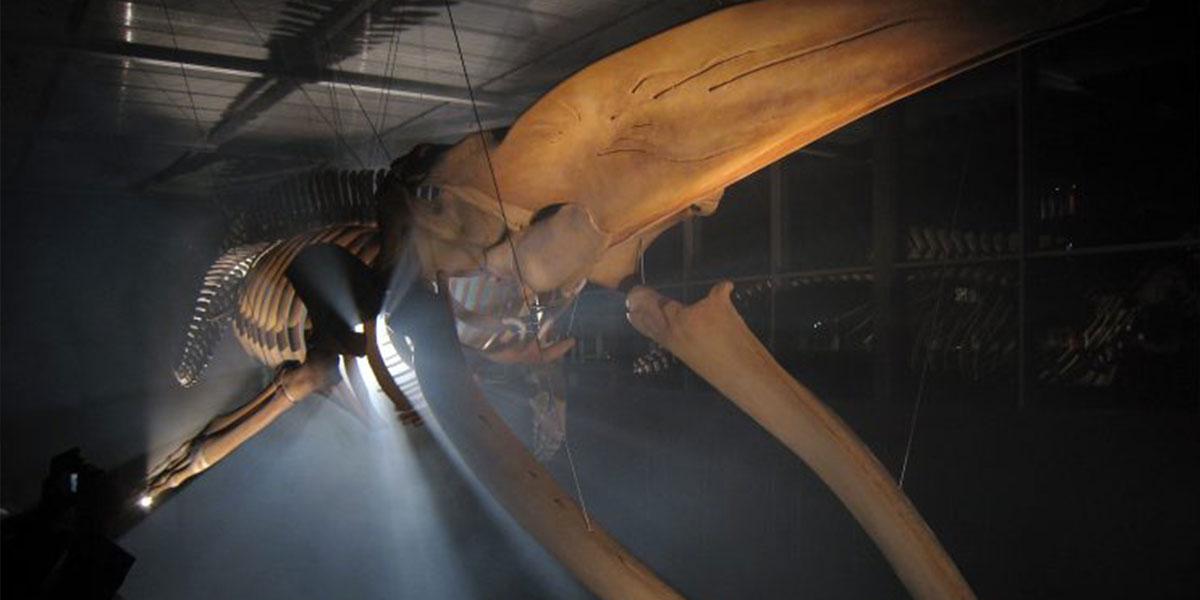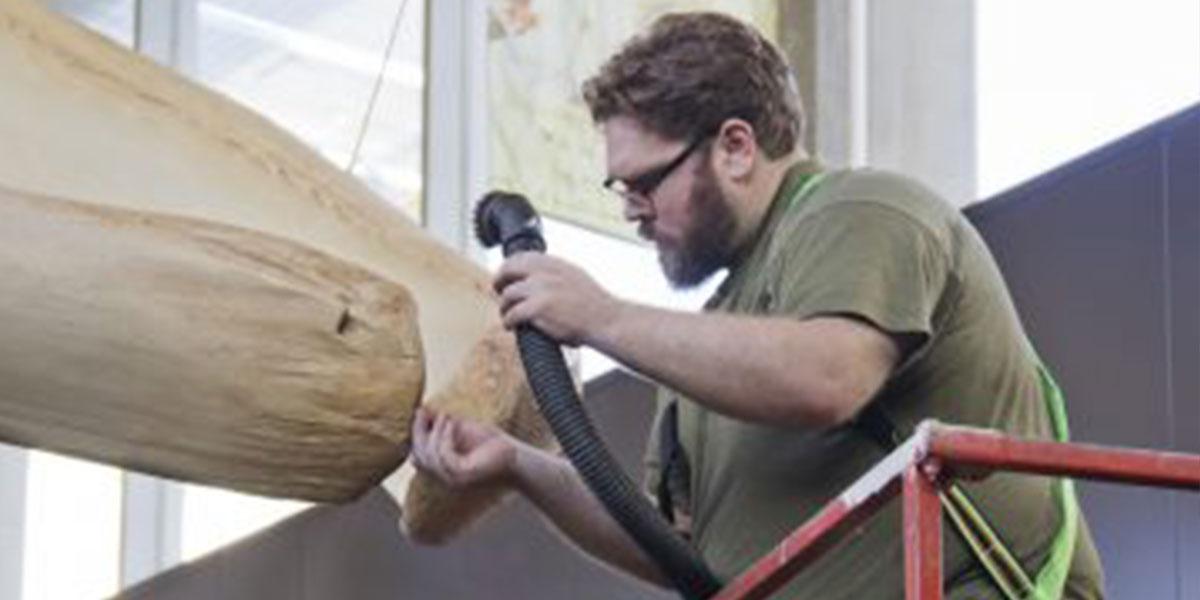Skeleton staff: curating the big blue whale


One of UBC’s most iconic sights is the 25-metre blue whale skeleton suspended over the entrance of the Beaty Biodiversity Museum. But while the closest most museum visitors are likely to get to the bony behemoth is the distance from which it looms above the floor, the same cannot be said for other members of the UBC community. And virtually no one is closer to this enormous creature than Chris Stinson, Curatorial Assistant of Mammals, Reptiles, and Amphibians.
You could say that Chris and the blue whale have a bit of a history—one that goes back to 2008, when he volunteered with the team that dug up the whale’s remains on the P.E.I. beach where it had been buried since 1987. It was a smelly business, he admits: “We stayed in a hotel that was a little ways away from the carcass. You’d hop out of the van and the wall of smell would hit you. When we were first there it was a mound of dirt, but I remember when we hit whale, so to speak. The excavator scraped the top off the mound, and then we hand shoveled because we didn’t want to hit the bones. And when we dug into the white powder that was left of the blubber—yeah, you could smell it.”
You could say that Chris and the blue whale have a bit of a history—one that goes back to 2008, when he volunteered with the team that dug up the whale’s remains on the P.E.I. beach where it had been buried since 1987. It was a smelly business, he admits: “We stayed in a hotel that was a little ways away from the carcass. You’d hop out of the van and the wall of smell would hit you. When we were first there it was a mound of dirt, but I remember when we hit whale, so to speak. The excavator scraped the top off the mound, and then we hand shoveled because we didn’t want to hit the bones. And when we dug into the white powder that was left of the blubber—yeah, you could smell it.”

Today, Chris’s relationship with the blue whale continues. As part of his duties include looking after mammal specimens, the whale falls under his jurisdiction, and he is responsible for maintaining the condition of the world’s largest suspended animal skeleton. The cleaning and repairs that took place in 2015, with the help of scissor lifts, were organized by Chris.
Asked if he feels affection for the skeleton, he replies, “I feel affection for all of the specimens that we have. And the whale falls under my jurisdiction because I look after the mammals. My boss [Ildiko Szabo], looks after the birds. I look after reptiles and amphibians, as well.”
Chris’s passion for nature was what first sparked his involvement with the Beaty Museum. While an undergraduate in animal biology at UBC, he began volunteering with the Cowan Tetrapod Collection in 2006 helping to move it into the newly constructed Beaty Museum in 2007. A part-time position followed, during which he completed a certificate in Museum Studies from UVic’s Cultural Resource Management program.
A true naturalist, Chris’s enthusiasm for biodiversity appears limitless. His formative years were spent exploring nature around his family’s home on the edge of Rainy Lake, just outside the small town of Fort Frances in Northwestern Ontario. “I used to have a collection of various bones and things I would find on beaches looking for things,” he reminisces. “I watched animals forever. There is a local wolf pack that used to go past our house out on the lake in the wintertime, and we would hear them howling.”
Today, he still explores nature every chance he gets. When he’s not handling specimens at the Beaty Museum, he spends his time on nature conservation projects. “I tend to usually volunteer some of my vacation time to work on various biological projects,” he says. “In 2014, I worked on the Oregon Spotted Frog for two weeks, up in the valley, tagging them for a population study. In 2015, I volunteered with Department of Fisheries and Oceans on a cetacean survey.”
I tend to usually volunteer some of my vacation time to work on various biological projects.
Chris Stinson

He keeps a running tally of all the species he’s seen in the wild, using an iNaturalist app. “I think I’m up to 5,000 species,” he says, proudly. He’s also got what is arguably one of the coolest side-gigs around; releasing raptors caught at the YVR airport back into the wild: “It’s a piecemeal contracting job. They live-trap them, and they get banded and marked, and if they’re a problem animal I drive them out to Chilliwack and let them go. It’s about one or two a month, usually on evenings or weekends.”
He keeps an eye out for interesting roadkill to bring back to the Beaty—“I picked up an opossum on zero avenue last weekend in Surrey”—and has a well-worn Tilley hat he wears when on his many adventures as an amateur entomologist and paleontologist. And every now and then, he says, the hat will emit a waft of something evocative to only a select few. “When it gets wet, you can catch a faint odor of sweet whale smell. No one else would really notice, but I do.”
About the Beaty Biodiversity Museum
Find the latest news, updates, events, and useful dates from across UBC, curated for faculty and staff by Internal Communications.
Access a library of resources from multiple UBC websites, all in one place.